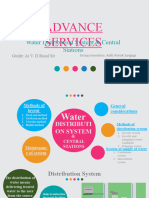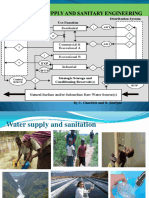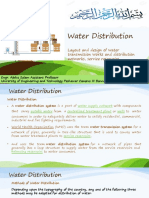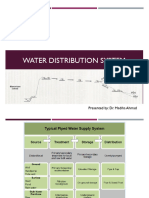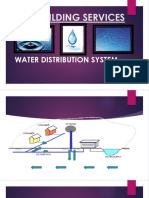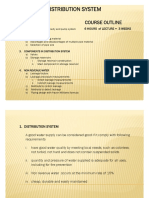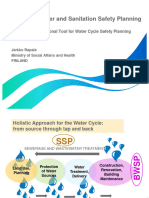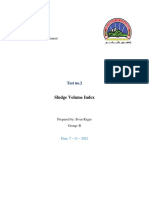10/10/2023
Lecture 12
Water Distribution
Subject: Environmental Engineering I
Section: Water Distribution
Water Distribution
Disclaimer: the material used in this presentation i.e., pictures/graphs/text, etc. is solely intended for
educational/teaching purpose, offered free of cost to the students for use under special circumstances of
Online Education due to COVID-19 Lockdown situation and may include copyrighted material - the use of
which may not have been specifically authorised by Copyright Owners. It’s application constitutes Fair Use
of any such copyrighted material as provided in globally accepted law of many countries. The contents of
presentations are intended only for the attendees of the class being conducted by the presenter.
.
1
� 10/10/2023
After completion of this class discussion the
students will be able to:
Discuss the operations & processes in water Distribution
The water, as it leaves the treatment plant, is of desired quality.
But the standard of this quality is to be maintained when the treated water is flowing
through the network of distribution system.
For these reasons, the following general considerations of the planning of distribution
system should be observed in its design:
2
� 10/10/2023
Design Considerations
Circulation of water
The layout of distribution system should be such that there is free circulation of water and
that the number of dead ends should
be very few.
Where dead ends are unavoidable, the hydrants will be provided to
act as washouts.
3
� 10/10/2023
Construction and design:
The construction and design of water distribution
system should be such that ample water is available at
all times at desired pressure in all portions of the
distribution system.
The minimum residual pressures at
ferrule point for direct supply to single-storeyed, two-
storeyed and three-storeyed
buildings should be respectively 7 m, 12 m and 17 m.
In general, the construction and design of the water
distribution system should be such that it can be
relied upon even for meeting future expansion
programs.
Contamination by sewage
The water pipe lines should be laid above the
sewers at a vertical distance of about 2 metres and the horizontal distance between
the water pipes and sewer should be at least 3 metres.
If the physical configuration of country does not permit the provisions of this minimum
spacing, extraordinary precautions should be taken to make the distribution system
watertight to the
maximum possible extent.
4
� 10/10/2023
Earth cushioning
The mains which are laid under roads should be provided with a minimum earth
cushioning of 900 mm height from the top of mains.
At other places, the cushioning may be of 750 mm height.
Economy
The layout and design of distribution system should be economical.
The cost of distribution system forms a substantial part to the extent of about
90 per cent of the total cost of the water supply project.
Hence, the water distribution system should be carefully designed by taking into
various factors such as:
Pumping head
Type of pipes
Storage requirement
Pipe diameter, etc.
10
5
� 10/10/2023
Fire demand
The distribution system should be so laid that the water for fire demand is available in
required quantity at desired pressure at number of points along it.
11
Gradients
It is not necessary to lay mains at constant gradients. But the gradients of mains should in
general follow the natural contour of ground.
The gradient line should not rise above the hydraulic gradient line which means that
at every point along the mains, there should be a positive pressure greater than the
atmospheric pressure.
12
6
� 10/10/2023
Leakage
The distribution system should be fairly watertight and the loss
of water due to leakage should be brought down to the minimum possible extent.
13
Repairs
The distribution system should be so laid as to permit
easy repairs.
The broken or worn out parts of the equipment for
various operations should
be properly replaced.
14
7
� 10/10/2023
Safety from pollution
The layout of distribution system should be such that it does not contribute to the pollution
of water flowing in it.
15
Sanitation
The sanitation of area through which the distribution
system is passing should be good so that there are no
chances for water to be polluted during repairs or
replacements of pipe lines.
16
8
� 10/10/2023
Unsafe cross connection
The distribution system should not have any unsafe cross connection from which there are
chances for contaminated water to enter it.
17
18
9
� 10/10/2023
Layouts of Distribution Network
The distribution pipes are generally laid below
the road pavements, and as such their layouts
generally follow the layouts of roads.
There are, in general, four different types of
pipe networks; any one of which either singly or
in combinations, can be used for a particular
place.
19
They are:
Dead End System
Radial System
Grid Iron System
Ring System
20
10
� 10/10/2023
Dead End System...
It is suitable for old towns and cities having no
definite pattern of roads.
21
Advantages
Relatively cheap.
Determination of discharges and pressure
easier due to less number of valves.
Disadvantages
Due to many dead ends, stagnation of water
occurs in pipes.
22
11
� 10/10/2023
Radial System...
The area is divided into different zones.
The water is pumped into the distribution
reservoir kept in the middle of each zone.
The supply pipes are laid radially ending
towards the periphery.
23
Advantages:
It gives quick service.
Calculation of pipe sizes is easy.
24
12
� 10/10/2023
Grid Iron System...
It is suitable for cities with rectangular layout,
where the water mains and branches are laid in
rectangles.
25
Advantages
Water is kept in good circulation due to the
absence of dead ends.
In the cases of a breakdown in some
section, water is available from some other
direction.
Disadvantages
Exact calculation of sizes of pipes is not
possible due to provision of valves on all
branches.
26
13
� 10/10/2023
Ring System...
The supply main is laid all along the peripheral roads
and sub mains branch out from the mains.
This system also follows the grid iron system with the
flow pattern similar in character to that of dead end
system.
So, determination of the size of pipes is easy.
27
Advantages
Water can be supplied to any point from at
least two directions.
28
14
� 10/10/2023
Methods of water distribution…
For efficient distribution system adequate water
pressure required at various points.
Depending upon the level of source, topography
of the area and other local conditions the water
may be forced into distribution system by
following ways -
29
1. Gravity system
2. Pumping system
3. Combined gravity and pumping system
30
15
� 10/10/2023
Gravity system…
Suitable when source of supply is at sufficient
height.
Most reliable and economical distribution
system.
The water head available at the consumer is just
minimum required.
The remaining head is consumed in the
frictional and other losses.
31
32
16
� 10/10/2023
Pumping system…
Treated water is directly pumped in to the distribution main with out
storing.
Also called pumping without storage system.
High lifts pumps are required.
If power supply fails, complete stoppage of water supply.
This method is not generally used.
33
34
17
� 10/10/2023
Combined gravity and pumping system
Most common system.
Treated water is pumped and stored in an
elevated distribution reservoir.
Then supplies to consumer by action of gravity.
The excess water during low demand periods
get stored in reservoir and get supplied during
high demand period.
Economical, efficient and reliable system.
35
36
18
� 10/10/2023
Distribution Reservoirs...
Distribution reservoirs, also called service
reservoirs, are the storage reservoirs, which
store the treated water for supplying water
during emergencies (such as during fires,
repairs, etc.) and also to help in absorbing the
hourly fluctuations in the normal water
demand.
37
Functions of Distribution Reservoirs
to absorb the hourly variations in demand.
to maintain constant pressure in the distribution
mains.
water stored can be supplied during emergencies.
Location and Height of Distribution Reservoirs
should be located as close as possible to the centre of
demand.
water level in the reservoir must be at a sufficient
elevation to permit gravity flow at an adequate
pressure.
38
19
� 10/10/2023
39
Types of
Reservoirs...
Depending upon their elevation w.r.t ground it
may be classified into
1. Surface reservoirs
2. Elevated reservoirs
40
20
� 10/10/2023
Surface reservoirs…
These also called ground reservoir.
Mostly circular or rectangular tank.
Under ground reservoirs are preferred
especially when the size is large.
These reservoirs are constructed on high
natural grounds and are usually made of
stones, bricks, plain or reinforced cement
concrete.
41
The side walls are designed to take up the
pressure of the water, when the reservoir is full
and the earth pressure when it is empty.
The position of ground water table is also
considered while designing these reservoirs.
The floors of these reservoirs may constructed
with R.C.C slab or square stone blocks resting
on columns.
42
21
� 10/10/2023
To obtain water tightness bitumen compounds
are used at all construction joints.
At the top of roof about 60cm thick earth layer
is deposited and maintained green lawns to
protect the reservoir from cold and heat.
For aeration of water and inspection, ventilation
pipes and stairs are provided.
43
Under Ground Reservoir
44
22
� 10/10/2023
The water may be supplied to the consumers by
either of the two systems.
1. CONTINUOUS SYSTEM
This is the best system and water is supplied for all
24 hours.
In this system sample of water is always available
for fire fighting and due to continuous circulation
water always remains fresh.
In this system less diameter of pipes are required
and rusting of pipes will be less. Losses will be more
if there are leakages in the system.
45
2. INTERMITTENT SYSTEM
If plenty of water is not available, the supply of
water is divided into zones and each zone is
supplied with water for fixed hours in a day or on
alternate days. As the water is supplied after
intervals, it is called intermittent system.
The system has following disadvantages:
• Pipelines are likely to rust faster due to alternate
wetting and drying.
• More wastage of water due to the tendency of the
people to store more water than required quantity
and to waste the excess to collect fresh water each
time.
• The repair work can be easily donein the non-
supply hours.
46
23
� 10/10/2023
47
24










